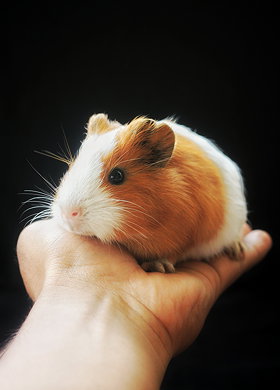Description:
The guinea pig or domestic guinea pig (Cavia porcellus), also known as the cavy or domestic cavy (/ˈkeɪvi/), is a species of rodent belonging to the genus Cavia in the family Caviidae. Despite their common name, guinea pigs are not native to Guinea, nor are they closely related biologically to pigs. They originated in the Andes of South America. They are domesticated animals that do not exist naturally in the wild, descendants of a closely related cavy species such as C. tschudii.
Most guinea pigs have fur, but one laboratory breed adopted by some pet owners, the skinny pig, is a mostly furless breed. Some breeds are long-fu
The guinea pig or domestic guinea pig (Cavia porcellus), also known as the cavy or domestic cavy (/ˈkeɪvi/), is a species of rodent belonging to the genus Cavia in the family Caviidae. Despite their common name, guinea pigs are not native to Guinea, nor are they closely related biologically to pigs. They originated in the Andes of South America. They are domesticated animals that do not exist naturally in the wild, descendants of a closely related cavy species such as C. tschudii.
Most guinea pigs have fur, but one laboratory breed adopted by some pet owners, the skinny pig, is a mostly furless breed. Some breeds are long-fur breeds such as the Peruvian, the Silkie and the Texel.
Guinea pigs can learn complex paths to food and can accurately remember a learned path for months. Their strongest problem-solving strategy is motion. While guinea pigs can jump small obstacles, they cannot jump very high. They startle easily, and when they sense danger either freeze in place for long periods, or run for cover with rapid, darting motions. When happily excited, guinea pigs may perform little hops in the air, a movement known as "popcorning". Guinea pigs are also good swimmers, although they do not like being wet and infrequently need bathing.
... (more)
(less)
My tags:
 Add tags
Add tags
 Login
Login





